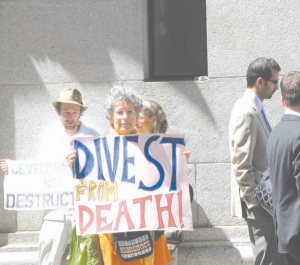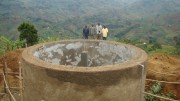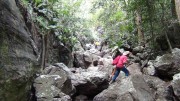While Goldcorp (G-T, GG-N) discussed plans for production growth and dividend increases at its annual shareholders’ meeting in Toronto on May 19, much of the conversation surrounded the gold miner’s practices at operations in Central and South America.
Prior to the meeting, a shareholder proposal calling on the company to adopt a new policy for consulting with indigenous communities was voted down with 90% of shareholders against it.
The proposal also asked Goldcorp to shut down its Marlin gold mine in Guatemala where there has been widespread community opposition since the mine opened five years ago.
Community members allege the company did not consult properly and that skin diseases, hair loss and water contamination have resulted from the Marlin operation. There has also been some violence attributed to the presence of the mine due to strong divisions in the community.
“The motion has asked us to shut down the mine, but we do not believe that makes sense,” Goldcorp president and CEO Chuck Jeannes told shareholders, arguing that the mine employs nearly 2,000 people.
Jeannes claims that Glamis Gold — later acquired by Goldcorp — conducted hundreds of meetings with thousands of people in the community during the development phase of the project.
However, Kathryn Anderson, who submitted the proposal and is a member of the Maritimes-Guatemala Breaking the Silence Network, says the company should follow certain international laws and treaties related to consulting indigenous people as well as be willing to hold a legally-binding referendum on such matters.
“If communities do not give free prior and informed consent, Goldcorp does not have the right to go into those communities and at every point (Chuck Jeannes) avoided that issue directly,” Anderson maintains.
Jeannes said the company would do better to improve its consultation process but disagreed with some interpretations of what this really means.
“The way it’s interrupted by some, if any individual objects we can’t go forward,” he asserted.
On May 17, a study on Goldcorp’s human rights practices at the Marlin mine was released. The study was requested by a group of shareholders and endorsed by Goldcorp.
According to the study, the mine has created jobs and improved infrastructure in the local communities, but said the company needs to do more to address its human rights concerns, especially its consultation process with locals.
Another study by two University of Michigan professors, released a day before the meeting, examined 23 residents near the Marlin mine. The study found those living near the mine had higher levels of mercury, copper, arsenic and zinc in their urine, as well as lead in their blood, than those living 7 km from the mine. However, the metal levels did not exceed what is considered acceptable by the United States Centers for Disease Control and Prevention. The professors conclude follow-up studies are needed to understand the effects.
During the question period, Carlos Amador, a teacher and community leader from Honduras, told shareholders that the reality is far from how Goldcorp presents it and was particularly concerned about the health problems people were experiencing and the company’s reclamation process at the San Martin gold mine in Honduras.
“What kind of social responsibility are we talking about?” he asked. “Who will control the acid drainage? Who is going to clean up the water contaminated with heavy metals?”
Jeannes said the reclamation at San Martin is not complete and that it would be taken care of. “It’s not only a Honduran government requirement but also one of our own.”
As for the medical problems, Jeannes said these are allegations the company has taken seriously over the last four years and noted that the company conducted numerous studies that all found that the mine was not the cause.
“And then we turned around saying, ‘let’s see what we can do to fix it,’ and I’m frustrated by the fact that at last year’s annual meeting, I begged people, ‘If you know anyone who has one of these skin diseases or problems, bring them to our facility,’ and it hasn’t happened,” Jeannes said.
He argues that malnutrition, hygiene issues and the lack of clean water could cause such problems in the areas where the company is operating.
During the meeting, dozens of protesters gathered outside the downtown Toronto hotel, chanting for Goldcorp to shut down its operations in Central and South America.
Goldcorp reported net earnings of US$588.2 million in 2009 and produced 2.9 million oz. gold. Production is expected to increase to 2.6 million in 2010 and the company plans to raise that to 3.8 million oz. by 2014.
This year, it projects to spend US$145 million on exploration and will also look for potential acquisitions of earlier-stage projects. “We haven’t bought a single ounce of reserves (in many years),” Jeannes said.
Goldcorp expects that its Peasquito mine in Mexico will reach full production of 500,000 oz. gold per year by the third quarter and the company will invest US$71 million developing a new zone at its Red Lake mine in northern Ontario. Red Lake mine should produce 675,000 oz. gold this year.






I have to side with Mr. Jeannes. If rigorous health surveys of the indigenous peoples were not conducted in past history……results from recent urine analysis mean nothing in terms of identifying the mine as the cause. Case in point…..in vast areas of the Northwest Territory in Canada, high levels of mercury occur naturally in fish. Fortunately for mining operations in this area of the world…this fact is documented prior to mining activity taking place.
The technology and development associated with mining is important for local economies in these areas of the world.
Protesters are all too often misinformed and a little too eager to grab attention ….a little to reluctant to do proper research and apply some forward thinking, and do themselves disservice this way.
This is a test comment